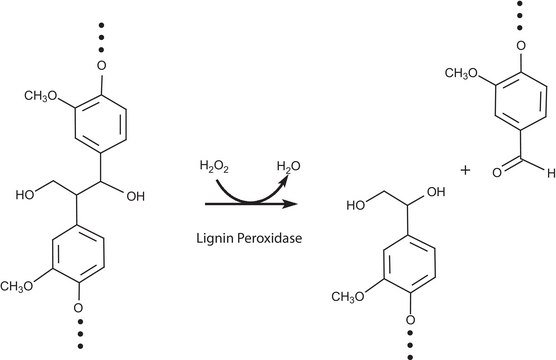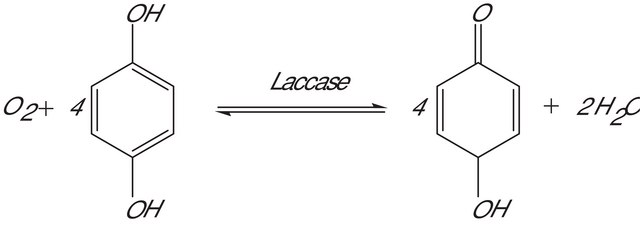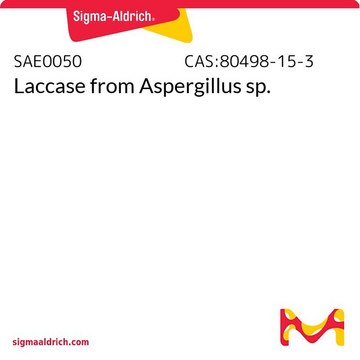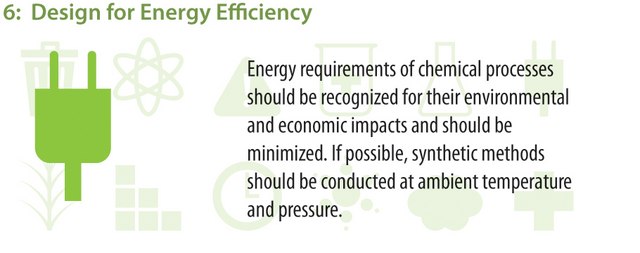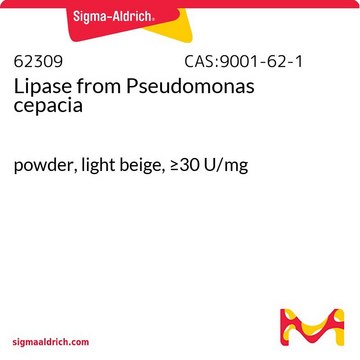41563
Manganese Peroxidase from Nematoloma frowardii
≥4.2 U/mg
Sign Into View Organizational & Contract Pricing
All Photos(1)
About This Item
CAS Number:
MDL number:
UNSPSC Code:
12352204
Recommended Products
biological source
fungus (Nematoloma frowardii)
Quality Level
form
powder
specific activity
≥4.2 U/mg
storage temp.
−20°C
Application
Manganese peroxidase (MnP) is used to oxidize Mn2+ to Mn3+ in the presence of hydrogen peroxide. It is used for the biodegreadation of macromolecular substances such as lignin and humic substances .
Biochem/physiol Actions
Manganese peroxidase (MnP) is a hemecontaining glycoprotein that is produced by ligninolytic basidiomycetes. It requires hydrogen peroxide as an oxidant. MnP oxidizes Mn2+ to Mn3+. Mn3+ oxidizes phenolic rings to phenoxy radicals which results in the decomposition of various compounds .
Packaging
Bottomless glass bottle. Contents are inside inserted fused cone.
Unit Definition
1 U corresponds to the amount of enzyme which oxidizes 1 μmol Mn2+ to Mn3+ per minute at pH 4.5 and 25°C (in the presence of H2O2).
Signal Word
Danger
Hazard Statements
Precautionary Statements
Hazard Classifications
Resp. Sens. 1
Storage Class Code
11 - Combustible Solids
WGK
WGK 3
Flash Point(F)
Not applicable
Flash Point(C)
Not applicable
Regulatory Information
常规特殊物品
Choose from one of the most recent versions:
Already Own This Product?
Find documentation for the products that you have recently purchased in the Document Library.
M Hofrichter et al.
Applied and environmental microbiology, 64(2), 399-404 (2005-12-14)
The direct involvement of manganese peroxidase (MnP) in the mineralization of natural and xenobiotic compounds was evaluated. A broad spectrum of aromatic substances were partially mineralized by the MnP system of the white rot fungus Nematoloma frowardii. The cell-free MnP
Dong-Soo Moon et al.
Applied biochemistry and biotechnology, 168(3), 542-549 (2012-07-14)
Alkylphenols are common endocrine disrupters that are produced from the degradation of widely used surfactants. Since they cause various harmful effects on aquatic life and in humans, they should be removed from the environments being contaminated. White rot fungus Irpex
Kannan Pakshirajan et al.
Journal of environmental management, 101, 118-123 (2012-03-13)
Coloured industry wastewaters often contain dyes and other toxic ingredients, and, therefore, pose serious threat to the receiving environment. Among the available methods the eco-friendly biological method has gained maximum attention due to its many advantages over the traditional methods.
Alexander N Kapich et al.
Enzyme and microbial technology, 49(1), 25-29 (2011-11-25)
The peroxidation of C18 unsaturated fatty acids by fungal manganese peroxidase (MnP)/Mn(II) and by chelated Mn(III) was studied with application of three different methods: by monitoring oxygen consumption, by measuring conjugated dienes and by thiobarbituric acid-reactive substances (TBARS) formation. All
Tomer M Salame et al.
Applied and environmental microbiology, 78(15), 5341-5352 (2012-05-29)
Pleurotus ostreatus (the oyster mushroom) and other white rot filamentous basidiomycetes are key players in the global carbon cycle. P. ostreatus is also a commercially important edible fungus with medicinal properties and is important for biotechnological and environmental applications. Efficient
Our team of scientists has experience in all areas of research including Life Science, Material Science, Chemical Synthesis, Chromatography, Analytical and many others.
Contact Technical Service
